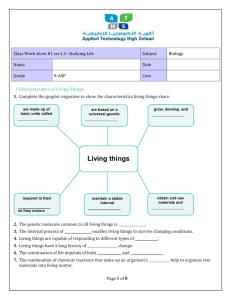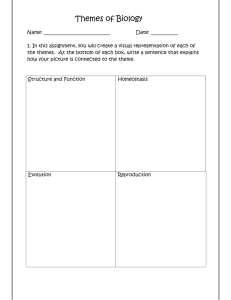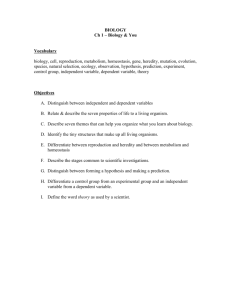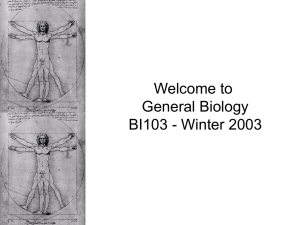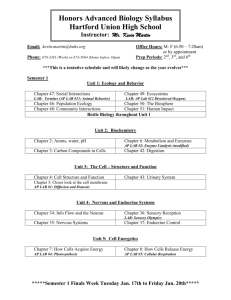Course Syllabus - Bishop Ireton High School
advertisement
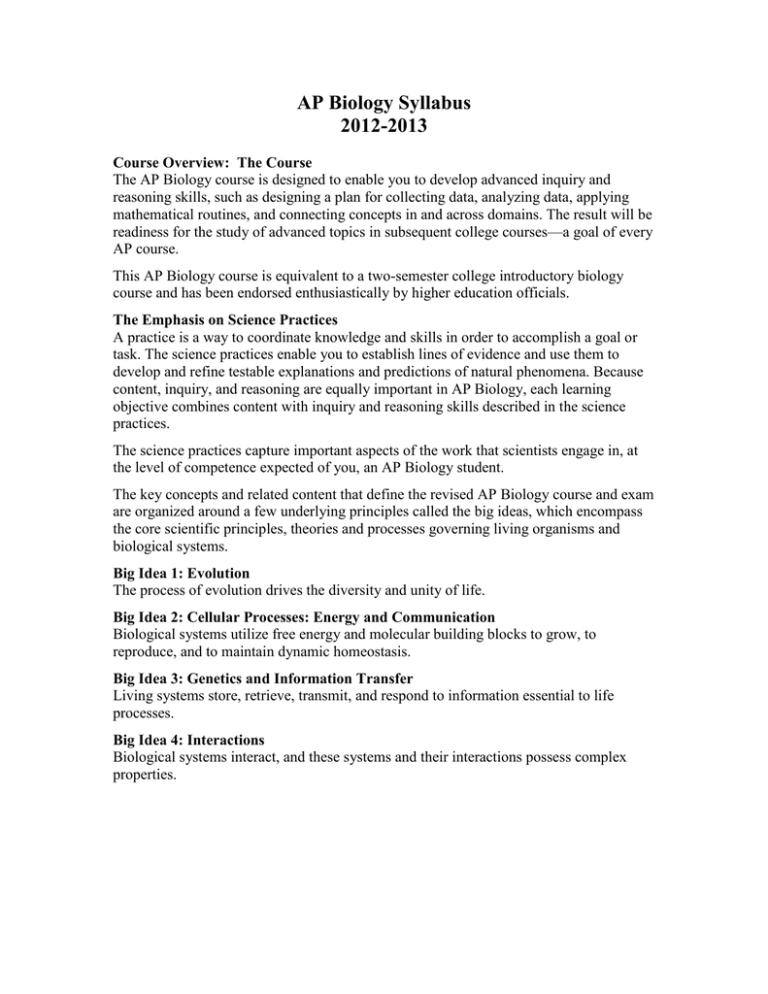
AP Biology Syllabus 2012-2013 Course Overview: The Course The AP Biology course is designed to enable you to develop advanced inquiry and reasoning skills, such as designing a plan for collecting data, analyzing data, applying mathematical routines, and connecting concepts in and across domains. The result will be readiness for the study of advanced topics in subsequent college courses—a goal of every AP course. This AP Biology course is equivalent to a two-semester college introductory biology course and has been endorsed enthusiastically by higher education officials. The Emphasis on Science Practices A practice is a way to coordinate knowledge and skills in order to accomplish a goal or task. The science practices enable you to establish lines of evidence and use them to develop and refine testable explanations and predictions of natural phenomena. Because content, inquiry, and reasoning are equally important in AP Biology, each learning objective combines content with inquiry and reasoning skills described in the science practices. The science practices capture important aspects of the work that scientists engage in, at the level of competence expected of you, an AP Biology student. The key concepts and related content that define the revised AP Biology course and exam are organized around a few underlying principles called the big ideas, which encompass the core scientific principles, theories and processes governing living organisms and biological systems. Big Idea 1: Evolution The process of evolution drives the diversity and unity of life. Big Idea 2: Cellular Processes: Energy and Communication Biological systems utilize free energy and molecular building blocks to grow, to reproduce, and to maintain dynamic homeostasis. Big Idea 3: Genetics and Information Transfer Living systems store, retrieve, transmit, and respond to information essential to life processes. Big Idea 4: Interactions Biological systems interact, and these systems and their interactions possess complex properties. Science Practices for AP Biology A practice is a way to coordinate knowledge and skills in order to accomplish a goal or task. The science practices enable students to establish lines of evidence and use them to develop and refine testable explanations and predictions of natural phenomena. These science practices capture important aspects of the work that scientists engage in, at the level of competence expected of AP Biology students. Science Practice 1: The student can use representations and models to communicate scientific phenomena and solve scientific problems. 1.1 The student can create representations and models of natural or man-made phenomena and systems in the domain. 1.2 The student can describe representations and models of natural or man-made phenomena and systems in the domain. 1.3 The student can refine representations and models of natural or man-made phenomena and systems in the domain. 1.4 The student can use representations and models to analyze situations or solve problems qualitatively and quantitatively. 1.5 The student can re-express key elements of natural phenomena across multiple representations in the domain. Science Practice 2: The student can use mathematics appropriately. 2.1 The student can justify the selection of a mathematical routine to solve problems 2.2 The student can apply mathematical routines to quantities that describe natural phenomena. 2.3 The student can estimate numerically quantities that describe natural phenomena. Science Practice 3: The student can engage in scientific questioning to extend thinking or to guide investigations within the context of the AP course. 3.1 The student can pose scientific questions. 3.2 The student can refine scientific questions. 3.3 The student can evaluate scientific questions. Science Practice 4: The student can plan and implement data collection strategies appropriate to a particular scientific question. 4.1 The student can justify the selection of the kind of data needed to answer a particular scientific question. 4.2 The student can design a plan for collecting data to answer a particular scientific question. 4.3 The student can collect data to answer a particular scientific question. 4.4 The student can evaluate sources of data to answer a particular scientific question. Science Practice 5: The student can perform data analysis and evaluation of evidence. 5.1 The student can analyze data to identify patterns or relationships. 5.2 The student can refine observations and measurements based on data analysis. 5.3 The student can evaluate the evidence provided by data sets in relation to a particular scientific question. Science Practice 6: The student can work with scientific explanations and theories. 6.1 The student can justify claims with evidence. 6.2 The student can construct explanations of phenomena based on evidence produced through scientific practices. 6.3 The student can articulate the reasons that scientific explanations and theories are refined or replaced. 6.4 The student can make claims and predictions about natural phenomena based on scientific theories and models. 6.5 The student can evaluate alternative scientific explanations. Science Practice 7: The student is able to connect and relate knowledge across various scales, concepts, and representations in and across domains. 7.1 The student can connect phenomena and models across spatial and temporal scales. 7.2 The student can connect concepts in and across domain(s) to generalize or extrapolate in and/or across enduring understandings and/or big ideas. The class is conducted at the college level and students are expected to work accordingly. The class meets 6 out of 7 days (due to a rotating schedule) for 48 minutes with a double period 1 out of 7 days. There will be class lecture, activities and labs. Hands on lab activities take up approximately 25% of the course time. Students are expected to read the selected material, take notes and complete any handouts such as questions or guided notes that will help them navigate through the material. Along with the factual information learned, student will be able to utilize the biological knowledge and demonstrate critical thinking through a series of written essays. Each unit culminates with a test consisting of multiple choice questions with corresponding essays. Each student is required to take the AP exam. Text: Biology, Campbell & Reese 9th ed. (Pearson publishers) Optional: Review book such as Cliff’s, Princeton Review, REA, Barron’s, Kaplan Reading of the text is extremely important. Students will be expected to take their own notes as they read in a composition notebook. The notes will be reviewed periodically for a completion grade. Typed notes will not be allowed. Internet: Students will be asked to view various internet sites such as Bozeman Biology on YouTube and Kahn Academy as part of their assignments. Labs: Labs will constitute at least 25% of the course work. The new curriculum includes more emphasis on inquiry based labs, which means you will design your own experimental procedures for a significant number of labs. In order to have as authentic a lab experience as possible, you will keep a lab notebook to record procedures and observations during labs. All labs will be done in pen. If you make a mistake, cross out (do not scribble out) the information and rewrite. In the scientific work, lab notebooks are considered legal documents and all information must be accessible. Formal lab write ups will be completed for each lab. You will turn in the formal write up. There will be a minimum of 2 labs for each of the 4 Big Ideas. Due to the large amount of time required for laboratory set-up, it is essential that students are present on lab days. Additional non AP labs are also performed throughout the year. AP Examination: (MAY 13, 2013) The exam is 3 hours long and includes both a 90minute multiple choice section and a 90-minute free-response section that begins with a mandatory 10-minute reading period. The multiple-choice section accounts for half of the student’s exam grade, and the free-response section accounts for the other half. AP Biology Exam Format Section I Question Type Number of Questions Part A: Multiple Choice 63 Part B: Grid-In 6 Timing 90 minutes Section II Question Type Number of Questions Timing Long Free Response 2 Short Free Response 6 80 minutes + 10-minute reading period Due to the increased emphasis on quantitative skills and application of mathematical methods in the questions on both sections, student will be allowed to use simple fourfunction calculators (with square root) on the entire exam. On a 5 point scale, a score of 3 or better is passing. All students are expected to take the AP exam. Grading Policies: Grades are calculated on a point system. Your grade will be calculated from homework, tests, quizzes, projects, labs, science in the news extra credit. Homework is worth 5-20 points depending on length. You will be able to track your grade by dividing the number of points received by the number of available points. You will maintain a grade sheet in the front of your book. This will help you monitor assignments, due dates, points received, and points available. The portal is also useful. Final Grade is calculated as follows: 40% quarter 1+ 40% Quarter 2+ 20%Semester 1 Exam=Semester 1 grade 40% quarter 2+ 40% Quarter 4+ 20%Semester 2 Exam=Semester 2 grade 50% Semester 1 grade + 50% Semester 2 grade =Final Grade Test/Homework Make- Up Policy: : For each day student is absent, he or she has one day to make up assignments .For tests and quizzes, students who miss one day have one day to make up a test or quiz. Students who miss two or more days have one full testing cycle to make up quizzes and tests. Students should discuss any conflicts with Mrs. Tunick immediately upon return. If you miss class due to early dismissal for a sporting event or other school activity and you are in school that day, the assignment is due that day as expected! Please see me in room 307 sometime before you leave the building. I do not count the absence as an excused absence. You do not receive an additional day. Absences: The policy outlined in the student handbook regarding tardiness and absences will be strictly followed. Four incidents of tardiness equal one unexcused absence. Four or more unexcused absences or five or more excused absences may result in no credit for that quarter. EXTRA CREDIT: Students may earn up to 10 extra credit points per quarter for presenting 10 science in the news items. These may come from the newspaper, the web, magazines, etc. Student must prepare a summary and report to the class their findings. Student may be asked questions by peers or instructor. Only one article per day/ per student with a maximum of 10 per quarter is allowed. The points will be added to the total points received at the end of the quarter. Course Policies: Students are expected to read the required chapters and keep detailed notes. No late work will be accepted Discussion is required. This class requires dedication and an immense amount of independent study time. You will get out of this class only what you are willing to contribute! HOMEWORK: Homework will be posted on my webpage. Go to the BI homepage and click on academics, faculty, and then Tunick. Contact Information: email: tunickr@bishopireton.org or rosetunes@aol.com Phone: 703-212-5140 ext. 8123 Office: rm 307 Teacher Availability: I am available for help M-F 7:15- 8:00am and M, T, W, R at 3:15. Please let me know if you will be coming in as situations may arise making me unavailable. Classroom Materials: Textbook- Campbell and Reese Biology 9th ed. 2”-3” 3- Ring binder with dividers: class notes, worksheets, tests, and quizzes Lab notebook-composition notebook Composition Notebook (for reading notes) Loose leaf paper Colored pencils, highlighter Pen, pencil Calculator -4 function Course Outline Unit 1: First Week and Introduction ( 5 classes) Big ideas: 1, 2 Connected to enduring understandings: 1.A Change in the genetic makeup of a population over time is evolution. 2.A Growth, reproduction and maintenance of the organization of living systems require free energy and matter. Chapters: 1. Introduction: Themes in the Study of Life 2. The Chemical Context of Life 3. Water and the Fitness of the Environment Unit 1 Overview of Lecture and Discussion Topics: 1. Darwin and the Theory of Natural Selection 2. Inquiry as a way to learn science 3. Structure of Atoms 4. Emergent Properties of Water 5. Design an Experiment- students walk through the experimental design process Unit 2: Biochemistry and Introduction to the Cell (10 Classes) Big ideas: 1, 2, 3, 4 Connected to enduring understandings: 1.D The origin of living systems is explained by natural processes. 2.A Growth, reproduction and maintenance of the organization of living systems require free energy and matter. 2.B Growth, reproduction and dynamic homeostasis require that cells create and maintain internal environments that are different from their external environments. 3.A Heritable information provides for continuity of life. 4.A Interactions within biological systems lead to complex properties. 4.B Competition and cooperation are important aspects of biological systems. 4.C Naturally occurring diversity among and between components within biological systems affects interactions with the environment. Chapters: 4. Carbon and the Molecular Diversity of Life 5. The Structure and Function of Large Biological Molecules 6. A Tour of the Cell 7. Membrane Structure and Function Unit 2 Overview of Lecture and Discussion topics: 1. The impact of carbon as the “backbone of life” 2. How monomers build polymers, including the roles of nucleic acids 3. Examples of organelles that are membrane bound to compartmentalize their functions 4. Membrane structure and function Unit 3: Cellular Energy and Related Processes (17 Classes) Big ideas: 1, 2, 4 Connected to enduring understandings: 1.A Change in the genetic makeup of a population over time is evolution. 1.D The origin of living systems is explained by natural processes. 2.B Growth, reproduction and maintenance of the organization of living systems require free energy and matter. 4.A Interactions within biological systems lead to complex properties. 4.B Competition and cooperation are important biological systems. Chapters: 8. An Introduction to Metabolism 9. Cellular Respiration 10. Photosynthesis Unit 3 Overview of Lecture and Discussion Topics: 1. Metabolic pathways 2. Laws of Energy Transformation 3. How ATP powers cellular work 4. Enzyme structure and function 5. Harvesting chemical energy: glycolysis, citric acid cycle, oxidative phosphorylation 6. Light reactions and the Calvin cycle 7. Evolution of alternative mechanism of carbon fixation Big Idea #2 Labs Investigation 4: Osmosis and Diffusion Lab Investigation 5: Plant pigment and photosynthesis Lab Investigation 6: Respiration Lab Big Idea #4 Labs Investigation 13: Enzyme Activity Unit 4: Cell Communication and the Cell Cycle (12 Classes) Big ideas: 1, 2, 3 Connected to enduring understandings: 2.E Many biological processes involved in growth, reproduction and dynamic homeostasis include temporal regulation and coordination 3.A Heritable information provides for continuity of life 3.B Expression of genetic information involves cellular and molecular mechanisms. 3.D Cells communicate by generating, transmitting and receiving chemical signals. Chapters: 11. Cell Communication 12. The Cell Cycle Unit 4 Overview of Lecture and Discussion Topics: 1. Evolution of cell signaling 2. Reception, transduction, response 3. Apoptosis 4. How mitosis produces genetically identical daughter cells 5. Evolution of Mitosis 6. How the eukaryotic cell cycle is regulated by a molecular control system 7. Origin of cell communication Big Ideas Lab #3 Investigation 7: Cell Division; Mitosis Carolina Biological: Cell Communication Kit for AP* Biology Unit 5: Genetic Basis of Life (12 Classes) Big ideas: 1, 3, 4 Connected to enduring understandings: 1.A Change in the genetic makeup of a population over time is evolution. 3.A Heritable information provides for continuity of life. 3.C The processing of genetic information is imperfect and is a source of genetic variation. 4.C Naturally occurring diversity among and between components within biological systems affects interactions with the environment. Chapters: 13. Meiosis and Sexual Life Cycles 14. Mendel and the Gene Idea 15. The Chromosomal Basis of Inheritance Unit 5 Overview of Lecture and Discussion Topics: 1. Genes are passed from parents to offspring by the inheritance of chromosomes 2. How meiosis reduces the number of chromosomes (diploid to haploid) 3. Evolutionary significance of genetic variation that results from sexual life cycles 4. Concepts of Mendelian genetics (laws of probability, inheritance patterns) 5. Genes are located along chromosomes (concepts of gene linkage, mapping distance between genes, causes of genetic disorders) [CR5] Big Ideas Lab #3 Investigation 7: Cell Division; Meiosis Unit 6: Gene Activity and Biotechnology (20 Classes) Big ideas: 1, 2, 3, 4 Connected to enduring understandings: 1.A Change in the genetic makeup of a population over time is evolution 2.C Organisms use feedback mechanisms to regulate growth and reproduction, and to maintain dynamic homeostasis. 2.E Many biological processes involved in growth, reproduction and dynamic homeostasis include temporal regulation and coordination. 3.A Heritable information provides for continuity of life. 3.B Expression of genetic information involves cellular and molecular mechanisms. 3.C The processing of genetic information is imperfect and is a source of genetic variation. 4.A Interactions within biological systems lead to complex properties. Chapters: 16. The Molecular Basis of Inheritance 17. From Gene to Protein 18. Regulation of Gene Expression 19. Viruses 20. Biotechnology 21. Genomes and their Evolution Unit 6 Overview of Lecture and Discussion Topics: 1. DNA is the genetic material (historical experiments, DNA structure and function, DNA replication) 2. Flow of genetic information (genetic code, role of other polymers, transcription, translation) 3. Mutations 4. Gene expression (operon systems in prokaryotes, eukaryotic gene expression) 5. Virus structure and activity 6. Restriction enzymes, plasmids, transformation 7. DNA technology (how gel electrophoresis works and applications of this technology) 8. M&M Chi Square Lab- Students use a bag of M&Ms and data from the Mars Company to determine if the number of each colored M&M is within the acceptable range for their individual bag. Big Ideas Lab #3 Investigation 8: Biotechnology: Bacterial Transformation DNA Goes to the Races (Carolina) Semester 1 Exam- Chapter 1-17 and Laboratories covered (Semester exam taken before winter break-Actual end of Semester 1 is after winter break) SECOND SEMESTER Unit 7: Evolution and Phylogeny (20 Classes) Big ideas: 1, 3, 4 Connected to enduring understandings: 1.A 1.B 1.C 1.D 3.A 3.C Change in the genetic makeup of a population over time is evolution. Organisms are linked by lines of descent from common ancestry. Life continues to evolve within a changing environment. The origin of living systems is explained by natural processes. Heritable information provides for continuity of life. The processing of genetic information is imperfect and is a source of genetic variation. 4.C Naturally occurring diversity among and between components within biological systems affects interactions with the environment. Chapters: 22. Descent with Modification: A Darwinian View of Life 23. The Evolution of Populations 24. The Origin of Species 25. The History of Life on Earth 26. Phylogeny and the Tree of Life 27. Bacteria and Archae Unit 7 Overview of Lecture and Discussion Topics: 1. How natural selection serves as a mechanism for evolution 2. Scientific evidence supporting evolution 3. Hardy-Weinberg concept 4. How allele frequencies can be altered in a population 5. Concepts of speciation 6. Origin of Life; Fossil Records 7. Events in the “history of life” (origin of single-celled and multicellular organisms; mass extinctions; adaptive radiations) Big Ideas Lab #1 Carolina Biological: Origin of Life Kit for AP* Biology Investigation 1: Artificial Selection Carolina Biological: Population Genetics and Evolution Kit for AP* Biology Investigation 3 Comparing DNA Sequences to Understand Evolutionary Relationships with BLAST Unit 8 Diversity in the Biological World: Organism Form and Function (22 Classes) Big ideas: 1, 2, 3, 4 Connected to enduring understandings: 1.A Change in the genetic makeup of a population over time is evolution. 1.B Organisms are linked by lines of descent from common ancestry. 2.A Growth, reproduction and maintenance of the organization of living systems require free energy and matter. 2.C Organisms use feedback mechanisms to regulate growth and reproduction, and to maintain dynamic homeostasis. 2.D Growth and dynamic homeostasis of a biological system are influenced by changes in the system’s environment. 2.E Many biological processes involved in growth, reproduction and dynamic homeostasis include temporal regulation and coordination. 3.E Transmission of information results in changes within and between biological systems. 4.A Interactions within biological systems lead to complex properties. 4.B Competition and cooperation are important aspects of biological systems. Chapters: 40. Basic Principles of Animal Form and Function 43. The Immune System 48. Neurons, Synapses, and Signaling 49.2 The Vertebrate Brain (Chapters 28-49 will be utilized to provide students with resources for the enduring understandings in this unit) Unit 8 Overview of Lecture and Discussion Topics: This section covers a broad survey of the diversity of life; specific topics will connect big ideas and enduring understandings. 1. Evolutionary trends (endosymbiosis, adaptations that allowed plants to move from water to land, reproductive adaptations of angiosperms, environmental roles of fungi, animal body plans, progressively complex derived characters in animal groups) 2. Unique features of the angiosperm life cycles 3. Signal transduction pathways (plant and animal hormones) 4. Photoperiodism in plants 5. Feedback control loops in animals 6. Thermoregulation in animals 7. Energy allocation and use in animals 8. Examples of functioning units in mammal systems (alveoli in lungs, villi of small intestines, nephrons in kidneys) 9. Structure and function in immune systems 10. Structure and function in nervous systems (neurons, resting potential, action potential, synapses) 11. Structure and function of the human brain Unit 9: Ecology (18 Classes) Big ideas: 1, 2, 3, 4 Connected to enduring understandings: 1.A Change in the genetic makeup of a population over time is evolution. 1.C Life continues to evolve within a changing environment. 2.A Growth, reproduction and maintenance of the organization of living systems require free energy and matter. 2.C Organisms use feedback mechanisms to regulate growth, reproduction and dynamic homeostasis. 2.D Growth and dynamic homeostasis of a biological system are influenced by changes in the system’s environment. 2.E Many biological processes involved in growth, reproduction and dynamic homeostasis include temporal regulation and coordination. 3.E Transmission of information results in changes within and between biological systems. 4.A Interactions within biological systems lead to complex properties. 4.B Competition and cooperation are important aspects of biological systems. 4.C Naturally occurring diversity among and between components within biological systems affects interactions with the environment. Chapters: 51. Animal Behavior 52.2. Interactions between organisms and the environment limit the distribution of species. 53. Population Ecology 54. Community Ecology 55. Ecosystems 56. Conservation Biology and Global Change Unit 9 Overview of Lecture and Discussion Topics: 1. Aspects of animal behavior 2. Aspects of biomes 3. Models describing population growth 4. Regulation of population growth 5. Community interactions 6. Species diversity and composition 7. Community biodiversity 8. Energy flow and chemical cycling in ecosystems 9. Primary productivity 10. Energy transfer between trophic levels 11. Human activities that threaten biodiversity Big Idea #4 Labs Investigation 10: Energy Dynamics Investigation 12 : Fruit Fly Behavior Projects: 1st Quarter- Book Reflection 2nd Quarter- Minority Scientist 3rd Quarter- Ecology Packet 4th Quarter –Endangered Species Presentation *Time frame is an approximation. Revisions may be made do to time fluctuations Remember we are completing this course in less than the standard 36 weeks. We have about 31 weeks counting breaks and holidays. We’re not done yet……… We will have plenty to keep us busy after the AP exam. Possibilities: Lorenzo’s Oil-students watch and answer questions NIH Epidemic Disease activity NIH DNA Chip activity HIH Human Genetic Diversity The Half Ton Man DVD- Discovery Health Channel program of a man who weighs 1000 pounds and his fight for life. Jurassic Park-FUN! Students are asked to watch and listen for any scientific terms that we have learned throughout the year. Animal Adaptations DVD- Discovery Channel program about animal adaptations and natural selection. Discovery Channel- Planet Earth series Semester 2 Exam Chapters 18-56 and Laboratories covered. All students will take the final exam during the senior exam testing period.
